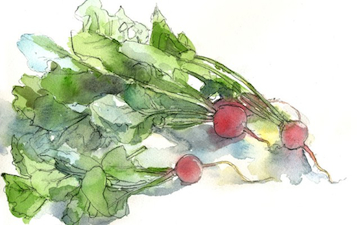The radish (Raphanus sativus) is an edible root vegetable of the Brassicaceae family that was domesticated in Europe in pre-Roman times. They are grown and consumed throughout the world. Radishes have numerous varieties, varying in size, color and duration of required cultivation time. There are some radishes that are grown for their seeds; oilseed radishes are grown, as the name implies, for oil production.
The descriptive Greek name of the genus Raphanus means “quickly appearing” and refers to the rapid germination of these plants. Raphanistrum from the same Greek root is an old name once used for this genus. The common name “radish” is derived from Latin (Radix = root).
Although the radish was a well-established crop in Hellenistic and Roman times, which leads to the assumption that it was brought into cultivation at an earlier time, Zohary and Hopf note that “there are almost no archeological records available” to help determine its earlier history and domestication. Wild forms of the radish and its relatives the mustards and turnip can be found over west Asia and Europe, suggesting that their domestication took place somewhere in that area. However Zohary and Hopf conclude, “Suggestions as to the origins of these plants are necessarily based on linguistic considerations.”[1]
(From Wikipedia, October 21st, 2010)
—
This familiar vegetable is eaten primarily for its fleshy taproot, which has a peppery flavor. The foliage can be eaten as well, but it is somewhat coarse. Many different cultivars have been developed, and escaped plants may vary somewhat in the appearance of their foliage and taproots. Another species, Raphanus raphanistrum (Wild Radish), has a similar appearance to Garden Radish. However, Wild Radish has yellow flowers and its siliques have 4-10 seeds. The siliques of Wild Radish become constricted between the seeds with maturity, and they tend to be a little longer and more slender than the siliques of Garden Radish.
While this plant is often grown in vegetable gardens, it is uncommon to find the Garden Radish in the wild. According to official records, it has naturalized in only a few counties (see Distribution Map). Habitats include dumps, edges of gardens, areas along roadsides and railroads, and waste areas. The preference is disturbed habitats, where this plant usually doesn’t persist. The Garden Radish probably originated from somewhere in Asia; it was cultivated as a vegetable by the Ancient Egyptians several thousand years ago.
(From EOL via Illinois Wildflowers, October 21st, 2010)
—




